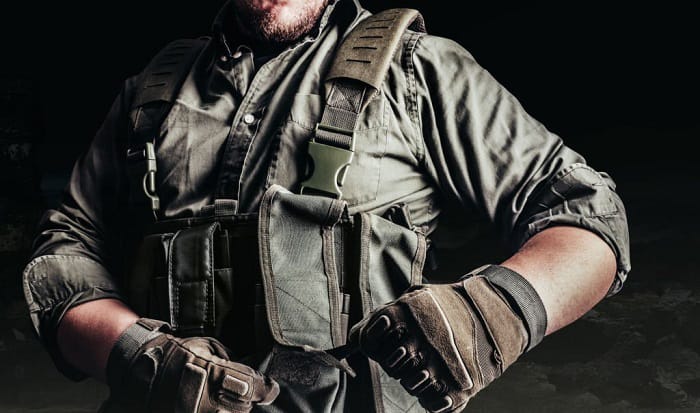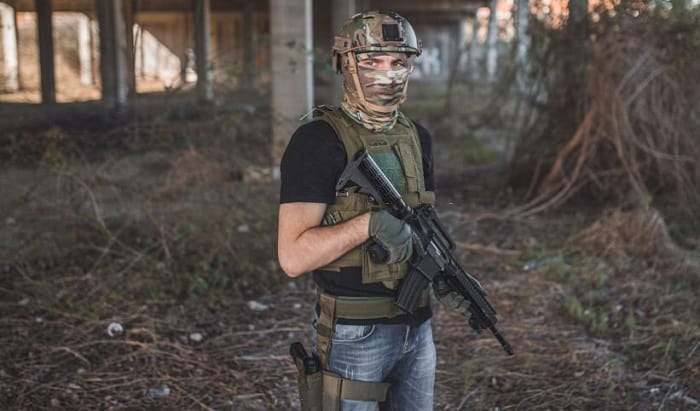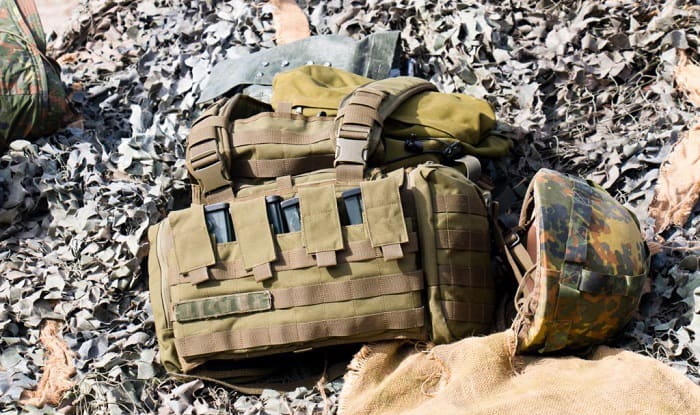In the past, soldiers had only one body armor option: heavy steel plate. But today, they have the luxury of choosing ceramic, steel, kevlar, and polyethylene. Of these materials, ceramic and steel are the most common.
Today’s article will look at ceramic vs. steel body armor. We will dive into the following details of ceramic body armor, steel body armor, recap, and pros and cons using information we have curated from various sites, including Reddit threads.
Thus, make sure you read until the very end to get the clearest picture of ceramic and steel body armors.
Table of Contents
Ceramic vs. Steel Plates & Armor
Ceramic Body Armor
There were ceramic prototypes as early as 1918, but they were not officially used in operations until the Vietnam War by helicopter crews.
Today, ceramic is typically used to insert into the outer layer of soft ballistic vests and serve as a type of composite armor. There can be two plates, one in the front and another in the back, or one single plate from the front to the back. For extra protection, certain vests also include small ceramic plates on the sides.
Ceramic armor designs can be monolithic plates or systems with 3D matrices. The former refers to a single plate of ceramic inserted in a traditional ballistic vest, replacing the steel plate.
On the other hand, the latter include cylindrical, hexagonal, and/or spherical ceramic elements held together with polyurethane foam and thick aluminum or non-armor alloy backing.
Ceramic body armors can stop rifle bullets. They are considered to provide National Institute of Justice Type III protection. The weight of a Type 3 NIJ plate is roughly 4 to 8 pounds, which is equivalent to 1.8 to 3.6 kilograms — for the standard 10″ by 12″ size. Nonetheless, other types of ceramic plates that come in varying sizes and offer varying levels of protection exist like ceramic body armor level 4.
Aside from body armors with ceramic plates, there are full-body ceramic armors. They remain in the market as an option, but there are a few reasons why most personnel will not recommend them.
First, they are thick and bulky. They can restrict your movements and give you a hard time. It is difficult to get in and out or on and off vehicles with them, and even bending down can become a problem. Restricted mobility not only affects your stealth and reflexes but also your abilities to shoot.
Second, you need to replace ceramic body armor after 5 to 7 years. Given the high price of these armors, they sure do make a cost-effective or economical option.
Third, ceramic full-body armors can shatter on impact. Even though it can stop 1 to 3 rounds, its stopping power does have a limit. In a fight fire where you get hit more than 3 times, it is very likely that your armor will shatter.
Fourth, ceramic armors require extra care. You do not have the option of simply throwing them in the back of your trunk, locker, or closet, as they can crack and become useless even before you make use of them.
Fifth, it can be difficult to detect fractures on them. In extreme cases, you may need to run them through X-rays to determine that they have been fractured. This, of course, costs you even more money.
Steel vs. Ceramic Plates & Armor
1. Steel Body Armor
On the other side of the scale are steel body armors. They have been around longer than ceramic armors and many retailers offer them today. One popular example is AR500 armor. Hence, you can find a lot if you search AR500 armor vs. ceramic.
Steel body armors are similar to ceramic body armors in that they can come as plates in a vest or suit or as full-body armor, and the designs can be monolithic plates or systems with matrices.
Like ceramic plates, steel plates come in multiple shapes and sizes. Nowadays, plates have angle cuts at the top, resembling a gravestone so they will not clash with the weapon shouldering. But most are straight and not curved. While curved plates are more comfortable, they are more likely to cause a ricochet. Therefore, steel armors are typically straight and uncomfortable, making it challenging for the wearer to move around and carry out basic tactical maneuvers.
The standard 10 by 12 inches plates will safeguard the lungs, heart, and section of the spine, but it will leave the head, pelvis, and rib cage sides uncovered. Then, in that case, there are 6 by 6 inches side plates. There are also 10 by 13.5 inches plates that are larger for the chest and back. But they add weight and require an extra large carrier pocket.
The two biggest advantages that steel has over ceramic are that they are cheap and long-lasting. While ceramic body armors can cost $249 on AR500 Armor, steel ceramic body armors only cost $129 to $139 on AR500 Armor.
As mentioned earlier, ceramic body armors can last for 5 to 7 years. Compared to this, steel body armors will not have to be replaced for 15 to 20 years.
However, steel is not light. Instead, it is stiff and uncomfortable. Most steel plates are about 0.25 inches thick and weigh around 7 to 8 pounds. So, they can definitely cause fatigue and possibly slow you down. Ceramic vs. steel plates weight concludes that the latter is lighter.
Moreover, steel plates that pad the torso area trap heat. This is a good thing in cold weather, but it is not pleasant under the blazing sun.
Most steel armors cannot stop armor-piercing rounds. and they cannot absorb impact. So, when you take a hit while wearing steel armor, it will feel like you have been stuck super hard, and this can sometimes even lead to collapsed lungs and broken ribs.
On top of that, steel armors can cause a ricochet. As it redirects the energy of hits and strikes, it causes bullets to steer into a different trajectory, which sounds like a good deal, but really isn’t. Why? Simply imagine: a bullet bouncing from your steel body armor (yay) but ending up hitting your arm (nay)!
2. Recap – Steel vs. Ceramic Body Armor
- Weight: Ceramic is lighter; steel is heavier.
- Longevity: Steel lasts longer; ceramic has to be replaced in fewer years.
- Cost: Steel is less expensive; ceramic is rather pricey.
- Lightweight
- Can stop rifle bullets
- Full-body armors are bulky and thick
- Its stopping power has a limit
- Can shatter and/or crack
- Require extra care
- Difficult to detect fractures
- Is cheap
- Lasts long
- Heavy, thick, and bulky
- Require larger carrier pockets
- Can trap heat
- Cannot absorb impact
Conclusion
Now, you have the full comparison of ceramic vs. steel body armor. You should know how they are the same and how they are different. If you are gathering information to decide on a material to purchase, we hope that our article has helped you make a choice. Tell us which you picked in the comments below! We (and other readers) would love to hear from you.

I am Everett Bledsoe, taking on the responsibility of content producer for The Soldiers Project. My purpose in this project is to give honest reviews on the gear utilized and tested over time. Of course, you cannot go wrong when checking out our package of information and guide, too, as they come from reliable sources and years of experience.



